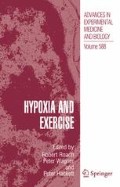Abstract
Reductions in arterial O2 saturation (−5 to −10 % SaO2 < rest) occur over time during sustained heavy intensity exercise in a normoxic environment, due primarily to the effects of acid pH and increased temperature on the position of the HbO2 dissociation curve. We prevented the desaturation via increased F1O2 (.23 to .29) and showed that exercise time to exhaustion was increased. We used supramaximal magnetic stimulation (1 – 100 Hz) of the femoral nerve to test for quadriceps fatigue. We used mildly hyperoxic inspirates (F1O2 .23 to .29) to prevent O2 desaturation. We then compared the amount of quadriceps fatigue incurred following cycling exercise at SaO2 98% vs. 91% with each trial carried out at equal exercise intensities (90% Max) and for equal durations. Preventing the normal exercise-induced O2 desaturation prevented about one-half the amount of exercise-induced quadriceps fatigue; plasma lactate and effort perception were also reduced. We conclude that the normal exercise-induced O2 desaturation during heavy intensity endurance exercise contributes significantly to exercise performance limitation in part because of its effect on locomotor muscle fatigue. These effects of EIAH were confirmed in mild environmental hypoxia (FIO2 .17, SaO2 88%) which significantly augmented the magnitude of exercise-induced quadriceps fatigue observed in normoxia.
Access this chapter
Tax calculation will be finalised at checkout
Purchases are for personal use only
Preview
Unable to display preview. Download preview PDF.
References
Dempsey JA and Wagner PD. Exercise-induced arterial hypoxemia. J Appl Physiol 87: 1997–2006, 1999.
Duhamel TA, Green HJ, Sandiford SD, Perco JG, and Ouyang J. Effects of progressive exercise and hypoxia on human muscle sarcoplasmic reticulum function. J Appl Physiol 97:188–196, 2004.
Fitts RH. Cellular mechanisms of muscle fatigue. Physiol Rev 74: 49–94, 1994.
Garner SH, Sutton JR, Burse RL, McComas AJ, Cymerman A, and Houston CS. Operation Everest II: neuromuscular performance under conditions of extreme simulated altitude. J Appl Physiol 68: 1167–1172, 1990.
Harms CA, McClaran SR, Nickele GA, Pegelow DF, Nelson WB, and Dempsey JA. Effect of exercise-induced arterial O2 desaturation on VO2max in women. Med Sci Sports Exerc 32: 1101–1108, 2000.
Nielsen HB, Boushel R, Madsen P, and Secher NH. Cerebral desaturation during exercise reversed by O2 supplementation. Am J Physiol 277: H1045–1052, 1999.
Hill AV. Muscular exercise, lactic acid and the supply and utilization of oxygen. Parts VII–VIII Proc Royal Soc Br 97: 155–176, 1924
Pickar JG, Hill JM, and Kaufman MP. Stimulation of vagal afferents inhibits locomotion in mesencephalic cats. J Appl Physioll 74: 103–110, 1993.
Sutton JR, Reeves JT, Wagner PD, Groves BM, Cymerman A, Malconian MK, Rock PB, Young PM, Walter SD, and Houston CS. Operation Everest II: oxygen transport during exercise at extreme simulated altitude. J Appl Physiol 64: 1309–1321, 1988.
Taylor AD, Bronks R, Smith P, and Humphries B. Myoelectric evidence of peripheral muscle fatigue during exercise in severe hypoxia: some references to m. vastus lateralis myosin heavy chain composition. Eur J Appl Physiol 75: 151–159, 1997.
Wetter TJ, St Croix CM, Pegelow DF, Sonetti DA, and Dempsey JA. Effects of exhaustive endurance exercise on pulmonary gas exchange and airway function in women. J Appl Physiol 91: 847–858, 2001.
Author information
Authors and Affiliations
Editor information
Editors and Affiliations
Rights and permissions
Copyright information
© 2006 Springer Science+Business Media, LLC
About this paper
Cite this paper
Romer, L.M., Dempsey, J.A., Lovering, A., Eldridge, M. (2006). Exercise-Induced Arterial Hypoxemia: Consequences For Locomotor Muscle Fatigue. In: Roach, R.C., Wagner, P.D., Hackett, P.H. (eds) Hypoxia and Exercise. Advances in Experimental Medicine and Biology, vol 588. Springer, Boston, MA. https://doi.org/10.1007/978-0-387-34817-9_5
Download citation
DOI: https://doi.org/10.1007/978-0-387-34817-9_5
Publisher Name: Springer, Boston, MA
Print ISBN: 978-0-387-34816-2
Online ISBN: 978-0-387-34817-9
eBook Packages: Biomedical and Life SciencesBiomedical and Life Sciences (R0)

